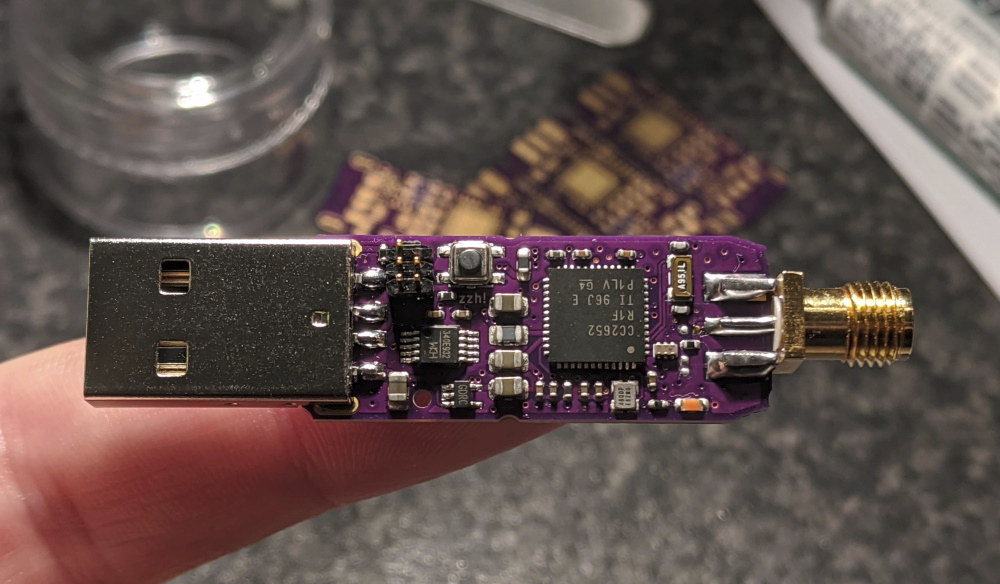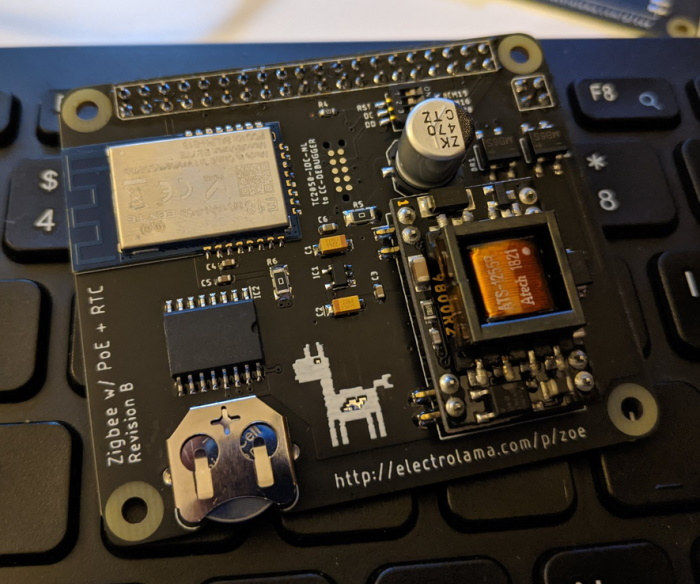Electrolama (@omerk and friends) has been working on two open-source hardware 802.15.4/Zigbee projects with “zig-a-zig-ah” (aka “zzh”) USB stick based on Texas Instruments CC2652R SimpleLink multi-standard wireless MCU and Zoe (Zigbee + Poe) development board based on Raspberry Pi HAT form factor and powered by TI CC2530 SimpleLink 2.4 GHz SoC alongside CC2592 range extender.
Both boards are released under an Apache-based Solderpad Hardware License 2.0, and target users of the Zigbee2MQTT project. The boards could soon also get native support in Home Assistant via the “zigpy-cc” library which adds support in ZHA (Zigbee Home Automation) integration component.
Zig-a-zig-ah USB Stick
Preliminary specifications:
- WiSoC – Texas Instruments CC2652R SimpleLink multi-standard wireless MCU with support for Thread, Zigbee, Bluetooth 5 Low Energy, IEEE 802.15.4g, 6LoWPAN, and proprietary systems. (Note: CC2652RB is also considered as it does not require an external crystal oscillator)
- Host Interface – USB via CH340 USB-UART bridge
- Misc – Push-button on BSL (bootstrap loader) pin for programming
- Debugging – SWD debug header (non-standard, requires a debug adapter board)
- SMA antenna port
Omer Kilic explains the board can see seen as an upgrade to CC2531 USB sticks with the 8051 MCU being replaced by a much faster Arm Cortex-M4F MCU @ 48 MHz in CC2652, along with more memory, and an open-source toolchain.
You’ll find more details on the product page and Github repository with EAGLE schematics and PCB layout.
Zoe Zigbee + PoE Raspberry Pi “HAT”
The second board looks like a Raspberry Pi HAT and is compliant to the standard except for one thing: no ID EEPROM.
Zoe specifications:
- WiSoC – Texas Instruments CC2530 along with CC2592 Range Extender (PA+LNA).
- Misc – RTC + battery slot
- Debugging – TagConnect to CC-Debugger footprint
- Power Supply – Passive 48V or IEEE 802.3af Power-over-Ethernet (PoE)
- Dimensions – Raspberry Pi HAT form factor
The board is meant to be connected to a Raspberry Pi board, optionally powered over PoE, and intended to be used as a Zigbee coordinator. The developer mentions no external programmer is required for flashing the Zigbee module thanks to flash_cc2531, an implementation of the Chipcon programming protocol. You’ll find instructions on the product page, and hardware design files on Github.
If you intended to use the Raspberry Pi’s WiFi and/or Bluetooth at the same time, you’ll be disappointed to learn you should disable it to prevent radio interference since everything operates at 2.4 GHz.
None of the boards are available right now, but they’ll be launched on Tindie when ready.
Thanks to Andreas for the tip.

Jean-Luc started CNX Software in 2010 as a part-time endeavor, before quitting his job as a software engineering manager, and starting to write daily news, and reviews full time later in 2011.
Support CNX Software! Donate via cryptocurrencies, become a Patron on Patreon, or purchase goods on Amazon or Aliexpress







Debugging – SWD debug header (non-standard, requires a debug adapter board)
– they mean TI jtag,
Misc – Push-button on BSL (bootstrap loader) pin for programming
– this works until the first erasing of the configuration bits in Flash Programmer
Hey, good spot re: “cJTAG”, fixed it in the documentation. Thanks!
BSL will work as long as BOOTLOADER_ENABLE in CCFG is set to 0xC5, which is the default value. If you change that value, it won’t work. I’ve just done a full erase on a prototype and it was still enabled afterwards but again if you deliberately go and erase/tinker with CCFG then it will stop working 🙂
Read an update now that ZoE HAT will also be based on TI CC2592 instead of CC2530/CC2531.
So both will use the same type of CC2592 chip.
CC2592 is just the RF range extender (PA+LNA), radio used on zoe is CC2530 plus that CC2592 for better RF performance than just the CC2530 itself.
zzh uses CC2652R, a much beefier and newer radio and I am also experimenting with CC2652P which has a built-in PA.
Any news on your tests with CC2652P with PA + LNA RF range extender?
Oh and since a couple of weeks back the native ZHA integration for Home Assiatant now works with all TI CC chips includibg these via zigpy-cc but support is still exprimental so do not migrate unless you are a developer or beta-tester who plats to help with its development
https://www.reddit.com/r/homeassistant/comments/fcrzvu/home_assistant_zha_now_have_native_support_for/
I love the open source hardware design here. I just have one question. Why is the HAT board, which is meant as a coordinator, the one without an SMA antenna port? I would have though it would have needed the best antenna, not some PCB style one. Am I misunderstanding something about Zigbee?
Someone asked the question on GitHub: https://github.com/electrolama/zoe/issues/2
Excellent, thank you.
Just a summary of that Github issue: There is a version of the E18 radio module I use on zoe that has an IPX/uFL connector on it that would allow you to use an external antenna with a suitable uFL-to-SMA cable that is very commonly used and easily procured.
That said, the PCB trace antenna and the CC2592 range extender does a very good job without the need of an external antenna in my opinion and experience. The key point to a sensible Zigbee deployment is to have routers distributed around the house to form a good mesh network, having the most powerful antenna on the coordinator is not going to magically fix all the range issues.
See that ZZH was sold out in less than 8-hours but I managed to get my order in before! 🙂
https://twitter.com/OmerK/status/1260118708703330306
Martin Ellis has now posted first impressions of a prototype zig-a-zig-ah board:
https://www.martinellis.me/posts/2020/03/zig-a-zig-ah/
Koen Kanters from Zigbee2mqtt also received prototype and posted this picture (left CC2531, right zzh):
https://user-images.githubusercontent.com/2892853/77303013-835cbd80-6cf2-11ea-8232-f49c184287e3.jpg
Koen Kanters wrote:
I’ve also received a zig-a-zig-ah board. Currently testing it in my production environment but so far really impressed!
– Small
– Good range (it has an SMA connector so you can decide what antenna to connect)
– Fast (because of it’s CC2652R)
– Can be flashed over USB (without additional hardware)
FYI, Koen Kanters (Koenkk) who develops Zigbee2mqtt and Zigbee-Shepherd (which other projects including IoBroker depends on ) has written that he has received a prototype Zig-a-zig-ah USB-dongle from Omer and it seems to work great so far with Zigbee2mqtt. Read his comments about it here: https://github.com/Koenkk/zigbee2mqtt/issues/1429#issuecomment-602485214
zig-a-zig-ah! Zigbee CC2652R USB dongle is now sold on Tindie for $35, and the Zoe Zigbee+PoE Raspberry Pi HAT for $45.
https://www.tindie.com/stores/electrolama/